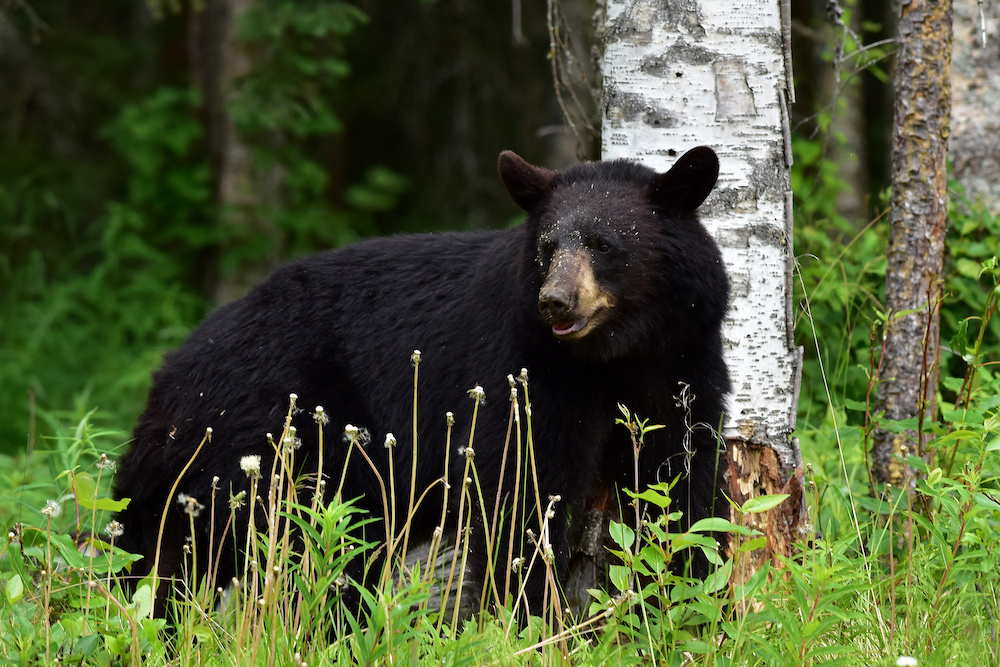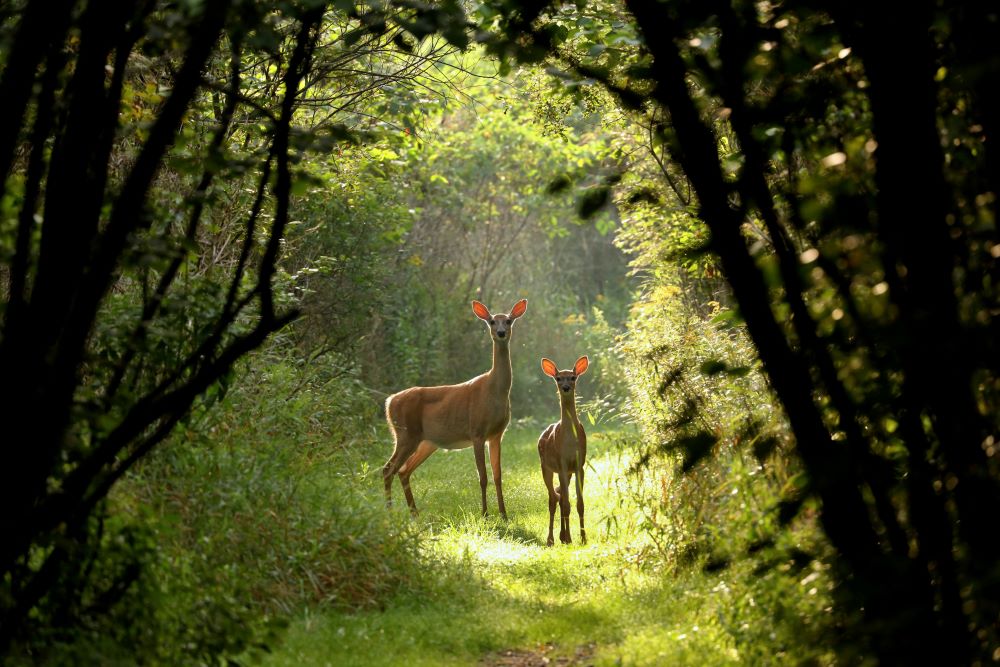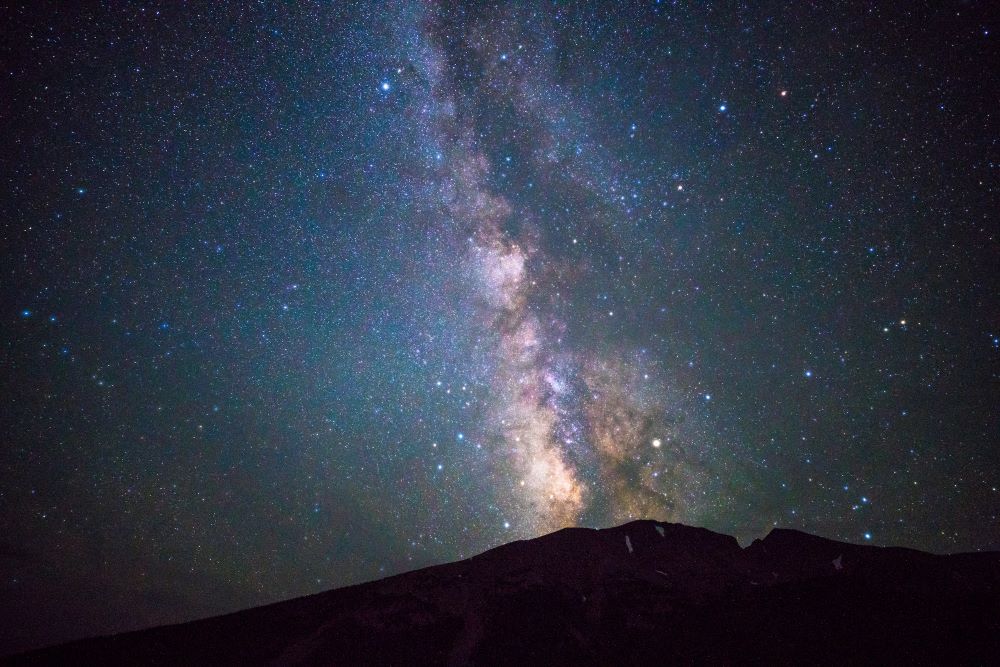Are there bears in Hocking Hills? Hocking Hills, Ohio, is renowned for its natural beauty, stunning landscapes, and abundant wildlife. Among the creatures that call this region home, one of the most captivating and awe-inspiring is the black bear (Ursus americanus). Although encounters with bears in Hocking Hills are rare, learning about these magnificent creatures can deepen our appreciation for the delicate balance of nature and the importance of wildlife conservation efforts.
Encountering native plants and animals while out hiking or enjoying nature is part of the adventure, of course. However, hikers generally want to know what the chances are of encountering any dangerous animals or plants before hitting the trails. We are here to help with a little guide the bears in Hocking Hills, including where they hang out (if at all) and how to prepare for a trip to Hocking with this in mind.
Bears in Hocking Hills
Black bears are native to Ohio and have a historical presence in the Hocking Hills region. They are adaptable animals that can thrive in a variety of habitats, including forests, swamps, and mountains. While their range has diminished over the years due to habitat loss and human activity, some reports suggest that black bears are making a slow comeback in certain parts of Ohio, including Hocking Hills.
Black bears historically roamed all over Ohio with frequent sightings in the past, but sometime around the mid-1850s, their numbers went down drastically due to hunting and habitat loss. As with most animals who experience unregulated hunting, sightings became more rare and some moved further away to neighboring states. Black Bears are now moving back to the rolling hills of Ohio to stake a claim. Most are coming from Tennessee, West Virginia, and Kentucky. Hocking, Ross, and Vinton Counties have listed several sightings since 2018. There are warnings advising people to be aware of where they have dens, what to look for in Spring when they wake up from hibernation, and how to prepare if a bear sighting occurs (hopefully from afar).
What Attracts Bears
Black bears are typically characterized by their glossy black fur, although some individuals may exhibit variations in coloration, such as cinnamon or brown. Adult males can weigh between 200 to 500 pounds, while females are generally smaller, ranging from 100 to 300 pounds. They are known for their keen sense of smell, strong climbing abilities, and relatively peaceful nature compared to their larger bear counterparts.
So, are there bears in Hocking Hills parks and near the trails?
While black bears are present in Ohio, sightings in Hocking Hills are rare and encounters with humans are even rarer. These elusive creatures tend to avoid areas heavily populated by humans and are more active during dawn and dusk. If you happen to catch a glimpse of a black bear during your visit to Hocking Hills, consider yourself fortunate, but always maintain a safe distance and observe from afar.
Once a black bear finds food, it can cause damage to property in an effort to get the food or find more. Finding food makes them likely to return to the site of their crime. They come for food at night most often, when they are more active, but can be seen at all hours.
Most commonly, bears in Ohio are attracted to:
- Trash
- Pet food
- Livestock feed
- Bird feeders
- Food waste that is easily accessible (campgrounds or camping areas)
Keeping your food in sealed containers is important when camping or in the woods if you want to avoid attracting bears to your pic-a-nik basket!
Tips for Bear Sightings in Hocking Hills
If you are exploring the wilderness of Hocking Hills, it’s important to be aware of bear safety precautions. Human activity generally scares bears away, so they’re unlikely to be found near humans. While black bears are generally not aggressive towards humans, it’s crucial to respect their space and minimize the likelihood of close encounters.
Here are a few guidelines to keep in mind to avoid encountering a bear:
- Keep a safe distance: If you spot a bear, maintain a distance of at least 100 yards. Admire them from afar and avoid approaching them.
- Secure food and garbage: Bears have a keen sense of smell and are attracted to food sources. When camping or picnicking, store your food in bear-resistant containers or suspend it from a tree limb to prevent bears from accessing it.
- Make noise: If you’re hiking or walking in bear country, make noise by talking, clapping, or singing. This alerts bears to your presence and reduces the chances of surprising them.
- Respect their territory: Bears are wild animals and deserve their space. Never attempt to feed or approach them, and always keep children and pets close by.
If you do encounter a bear, and it starts to come closer, follow these guidelines to maintain safety:
- Remain Calm: If you spot a bear approaching or within close proximity, it’s natural to feel a sense of unease. However, it’s important to remain calm and avoid panicking. Panicking or making sudden movements may startle the bear and potentially escalate the situation.
- Assess the Situation: Evaluate the bear’s behavior and try to determine its intentions. In most cases, bears are simply curious or may be searching for food. If the bear does not display any signs of aggression and appears to be minding its own business, you can often safely observe it from a distance without engaging further.
- Maintain a Safe Distance: Keep a significant distance between yourself and the bear. Slowly and calmly back away, creating space between you and the bear. Avoid running, as this may trigger a chase response. Aim to maintain a distance of at least 100 yards to reduce the chance of the bear feeling threatened.
- Make Yourself Known: Make your presence known to the bear by speaking calmly and firmly. This alerts the bear to your presence and allows it to identify you as a human. You can also raise your arms to appear larger and wave them slowly. Avoid making sudden movements or direct eye contact, as this may be interpreted as a threat.
- Create Noise: If the bear continues to approach or shows signs of aggression, it’s important to deter it by making loud noises. Shout, clap your hands, or use a whistle to make as much noise as possible. This can startle the bear and make it retreat.
- Back Away Slowly: While keeping an eye on the bear, slowly and carefully move away from it. Do not turn your back on the bear or run, as this may trigger its predatory instincts. Make sure to watch the bear’s behavior while slowly backing away until you reach a safe distance.
Remember, it’s crucial to respect and admire bears from a distance. Keep in mind that their behavior can be unpredictable, and it’s important to prioritize safety for both yourself and the bear. Understanding bear behavior, practicing proper wilderness etiquette, and being prepared can help ensure a safe and enjoyable experience when exploring the beautiful wilderness of Hocking Hills.
Chances of Bear Sightings
The presence of bears in Hocking Hills should not be intimidating as only 100 are estimated to be living in the whole state of Ohio. Black Bears are endangered species in Ohio and sightings are rare.
Protecting the habitat and preserving the natural environment is essential for the long-term survival of black bears and other wildlife in Ohio. Conservation efforts, such as preserving large tracts of land, maintaining healthy ecosystems, and promoting responsible outdoor practices, play a crucial role in ensuring the continued existence of these magnificent creatures.
Encountering a black bear in Hocking Hills is an incredibly rare and special experience. While it’s important to appreciate their beauty and role in the ecosystem, it’s equally important to prioritize safety and conservation. By respecting their natural habitat and following bear safety guidelines, we can coexist harmoniously with these remarkable creatures and contribute to the preservation of Hocking Hills’ diverse wildlife.
To track wildlife, report sightings to the county wildlife officer or specialist by
calling 1-800-WILDLIFE to report sightings to ODNR.











Share This Page